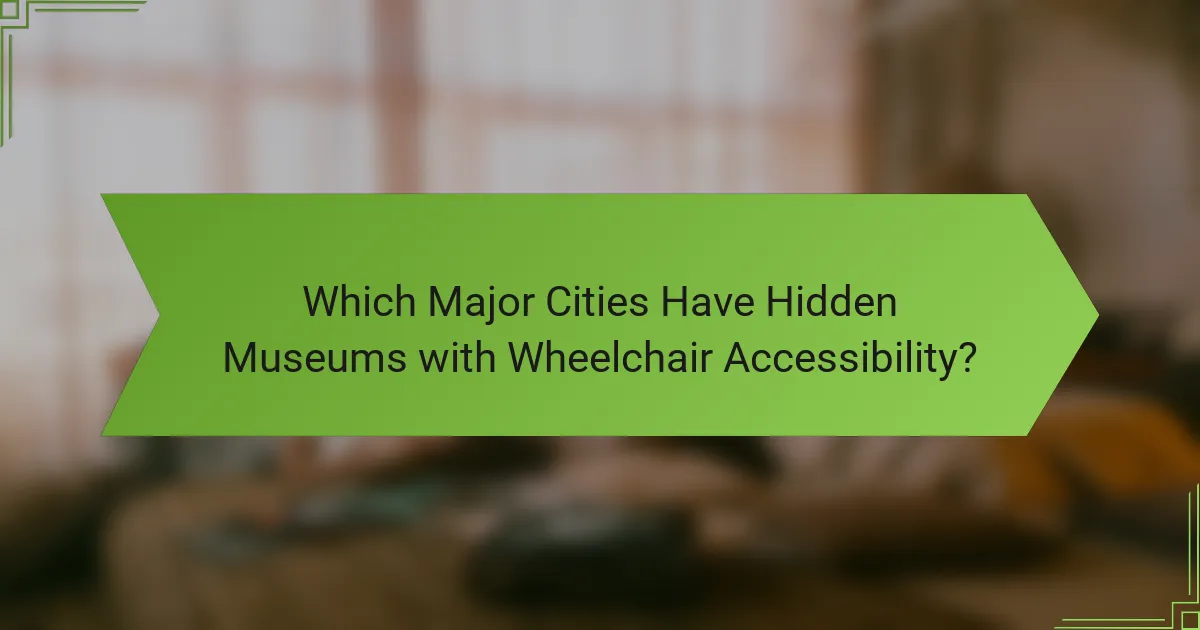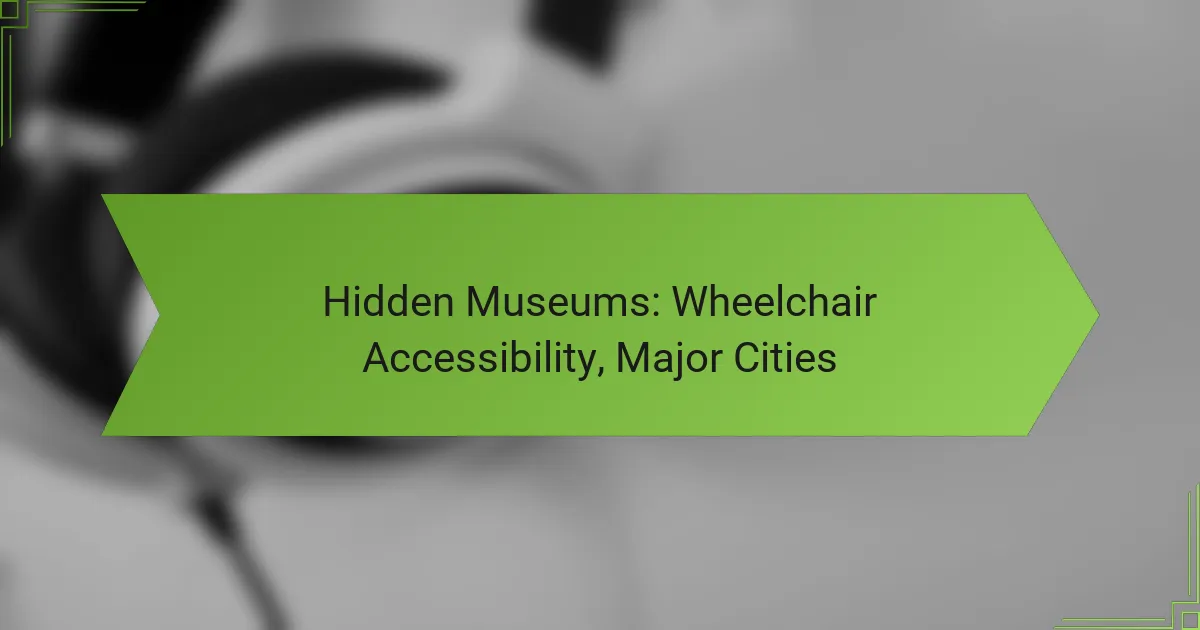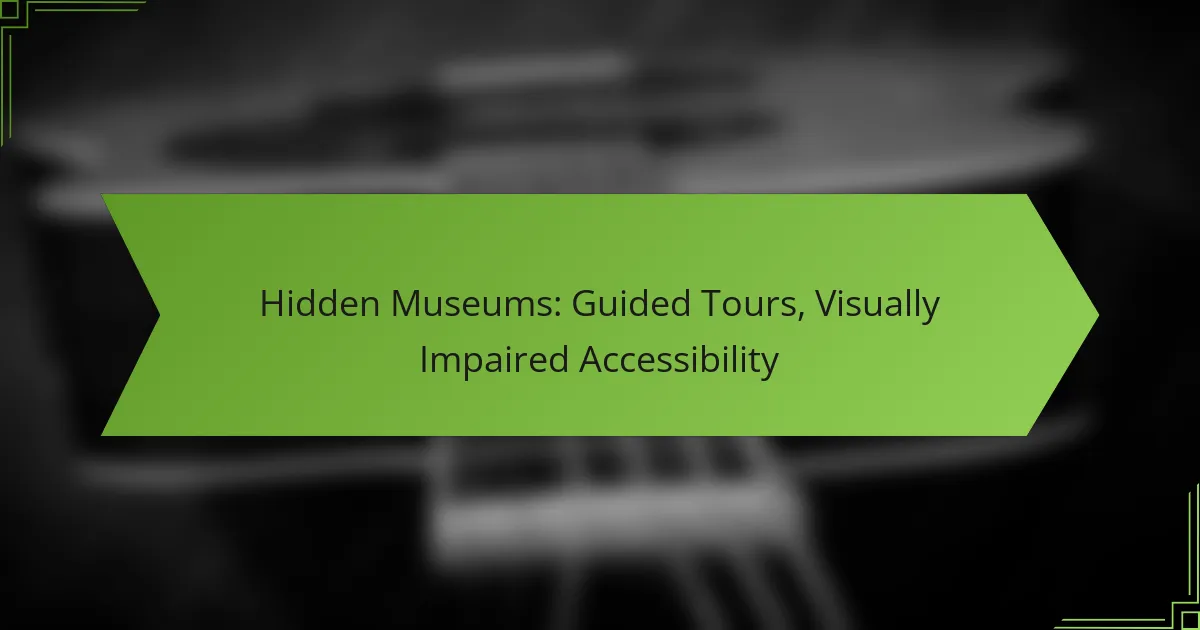Many major cities boast hidden museums that prioritize wheelchair accessibility, making cultural experiences available to everyone. These venues often feature essential amenities such as ramps, elevators, and accessible restrooms, ensuring a comfortable visit for all. To discover these inclusive spaces, utilize online resources and local guides that highlight accessibility options in your area.

Which Major Cities Have Hidden Museums with Wheelchair Accessibility?
Several major cities feature hidden museums that are wheelchair accessible, ensuring inclusivity for all visitors. These locations often provide unique cultural experiences while adhering to accessibility standards.
New York City
New York City is home to numerous hidden museums that cater to wheelchair users. The Tenement Museum, for instance, offers accessible tours that delve into the immigrant experience in America. Additionally, the Museum at the Fashion Institute of Technology provides wheelchair access throughout its exhibits.
When planning a visit, it’s advisable to check each museum’s website for specific accessibility features, such as ramps, elevators, and accessible restrooms. Many museums also offer guided tours tailored for visitors with mobility challenges.
San Francisco
San Francisco boasts several hidden gems like the Contemporary Jewish Museum, which is fully wheelchair accessible. The museum features a range of exhibitions that highlight Jewish culture and history, all while ensuring that visitors with mobility issues can navigate comfortably.
Before visiting, confirm the availability of accessible parking and public transport options. The city’s Muni system is generally accommodating, but checking routes in advance can save time and effort.
Chicago
In Chicago, the International Museum of Surgical Science is a lesser-known venue that provides wheelchair access. This museum offers fascinating insights into the history of surgery and medical instruments, making it a unique stop for those interested in medical history.
Ensure to inquire about any special programs or tours designed for individuals with disabilities. Many museums in Chicago are committed to providing a welcoming experience, so don’t hesitate to reach out for assistance.
Los Angeles
Los Angeles features hidden museums like the Museum of Jurassic Technology, which is accessible to wheelchair users. This quirky museum combines art and science in unexpected ways, making it a must-visit for those seeking something different.
Check for any specific accessibility services offered, such as guided tours or assistive listening devices. It’s also beneficial to look into nearby parking options that accommodate accessible vehicles.
Washington, D.C.
Washington, D.C. has hidden museums such as the National Museum of Women in the Arts, which is fully wheelchair accessible. This museum showcases the contributions of women artists and offers a rich cultural experience for all visitors.
Before your visit, verify the museum’s accessibility features, including elevators and seating areas. Many D.C. museums are located near accessible public transportation, making it easier to plan your trip.

What Are the Wheelchair Accessibility Features in Hidden Museums?
Hidden museums often incorporate various wheelchair accessibility features to ensure all visitors can enjoy their exhibits. Key elements include ramps, elevators, accessible restrooms, and specialized guided tours tailored for wheelchair users.
Ramps and Elevators
Ramps and elevators are essential for wheelchair accessibility in hidden museums. Ramps should have a gentle slope, ideally not exceeding a 1:12 ratio, to facilitate easy navigation. Elevators must be spacious enough to accommodate wheelchairs and should be clearly marked for easy identification.
When planning a visit, check the museum’s website or contact them directly to confirm the availability and condition of ramps and elevators. Some museums may have temporary closures or maintenance that could affect accessibility.
Accessible Restrooms
Accessible restrooms are crucial for wheelchair users visiting hidden museums. These facilities should be equipped with grab bars, sufficient space for maneuverability, and accessible sinks. It’s advisable to look for signs indicating the location of accessible restrooms upon arrival.
Before visiting, verify that the museum meets local accessibility standards, which often require at least one accessible restroom on each floor. This ensures that all visitors can comfortably use the facilities during their visit.
Guided Tours for Wheelchair Users
Many hidden museums offer guided tours specifically designed for wheelchair users, providing an inclusive experience. These tours often feature accessible routes and knowledgeable guides who can accommodate individual needs. It’s beneficial to inquire about the availability of such tours when planning your visit.
Some museums may require advance reservations for wheelchair-accessible tours, so it’s wise to book early. Additionally, check if they provide any assistive devices or services, such as audio guides or sign language interpreters, to enhance the experience for all visitors.

How to Find Hidden Museums with Wheelchair Access?
To find hidden museums with wheelchair access, start by researching online resources and local guides that focus on accessibility. Many cities have specific tools and platforms dedicated to helping visitors identify venues that accommodate mobility needs.
Online Accessibility Guides
Online accessibility guides are invaluable for discovering hidden museums that cater to wheelchair users. Websites like Accessible Travel and Wheelchair Travel provide detailed information about accessibility features, including ramps, elevators, and restroom facilities. These resources often include user reviews and ratings, which can give you insights into the actual experiences of other visitors.
When using these guides, look for specific mentions of wheelchair access in the museum’s description. Some sites even allow you to filter results based on accessibility options, making it easier to find suitable locations.
Local Tourism Websites
Local tourism websites are another excellent source for finding hidden museums with wheelchair access. Many cities maintain official tourism portals that highlight attractions, including accessibility information. Check sections dedicated to visitor services or accessibility to find relevant details.
Additionally, these websites often feature maps and itineraries that can help you plan your visit. Look for contact information to inquire directly about specific accessibility features if the information is not readily available online.
Social Media Recommendations
Social media platforms can provide real-time recommendations for hidden museums with wheelchair access. Join local groups or forums on platforms like Facebook or Reddit, where members share their experiences and tips. You can ask for suggestions or search previous posts for insights on accessible venues.
Instagram and Twitter can also be useful for discovering museums. Look for hashtags related to accessibility, such as #AccessibleTravel or #WheelchairFriendly, to find posts from other visitors that may highlight hidden gems in major cities.

What Are the Benefits of Visiting Wheelchair Accessible Museums?
Visiting wheelchair accessible museums offers numerous advantages, including the ability to enjoy cultural experiences without barriers, enhanced educational opportunities, and increased community involvement. These benefits contribute to a more inclusive environment for all visitors, ensuring that everyone can appreciate art and history.
Inclusive Cultural Experiences
Wheelchair accessible museums provide inclusive cultural experiences by ensuring that all visitors can engage with exhibits and programs. Accessibility features such as ramps, elevators, and designated seating areas allow individuals with mobility challenges to explore the museum comfortably.
Many museums also offer guided tours specifically designed for visitors with disabilities, enhancing the overall experience. These tours often include additional resources, such as tactile exhibits and audio descriptions, making art and history accessible to everyone.
Enhanced Learning Opportunities
Accessible museums create enhanced learning opportunities by allowing individuals with disabilities to participate fully in educational programs. Workshops, lectures, and interactive exhibits are often tailored to accommodate various needs, ensuring that all participants can benefit from the learning experience.
For example, some museums provide sign language interpreters or materials in braille, which can significantly improve understanding and engagement for visitors with hearing or visual impairments. This commitment to accessibility fosters a richer educational environment for all attendees.
Community Engagement
Community engagement is strengthened when museums prioritize wheelchair accessibility. By welcoming individuals of all abilities, museums can attract a diverse audience, fostering connections among community members. This inclusivity encourages dialogue and collaboration, enriching the cultural fabric of the area.
Additionally, accessible museums often partner with local organizations to promote events and programs that cater to individuals with disabilities. These partnerships can lead to greater awareness and support for accessibility initiatives, benefiting the entire community.

What Criteria Should You Consider for Choosing Accessible Museums?
When selecting accessible museums, consider factors such as location, accessibility ratings, and visitor reviews. These elements will help ensure a comfortable and enjoyable experience for wheelchair users.
Location and Proximity
Choosing a museum’s location is crucial for accessibility. Look for museums that are situated near public transportation options, parking facilities, and accessible pathways. Proximity to hotels or restaurants can also enhance the overall experience.
In major cities, consider the availability of curb cuts and ramps in the surrounding area. Museums located in pedestrian-friendly zones tend to offer better accessibility for wheelchair users.
Accessibility Ratings
Accessibility ratings provide valuable insights into how well a museum accommodates wheelchair users. Many organizations and websites evaluate museums based on criteria such as wheelchair access, restroom facilities, and exhibit navigation.
Check resources like the American with Disabilities Act (ADA) compliance ratings or local accessibility guides. A rating of 4 stars or higher typically indicates a strong commitment to accessibility.
Visitor Reviews
Visitor reviews can offer firsthand accounts of a museum’s accessibility features. Look for comments specifically mentioning wheelchair access, ease of navigation, and the helpfulness of staff.
Websites like TripAdvisor or Yelp often have filters for accessibility, allowing you to read reviews from other wheelchair users. Pay attention to recurring themes in the feedback to gauge the museum’s overall accessibility experience.

What Are Some Unique Hidden Museums Worth Visiting?
Hidden museums offer unique experiences and insights into niche topics that are often overlooked. These museums can provide a more intimate and specialized understanding of art, history, or culture, making them worthwhile destinations for curious travelers.
The Museum of Bad Art (MOBA)
Located in Massachusetts, the Museum of Bad Art showcases art that is intentionally or unintentionally poor in quality. This quirky museum celebrates the humor and creativity found in less-than-stellar artworks, making it a fun stop for art enthusiasts and casual visitors alike.
MOBA features a rotating collection of pieces that are often humorous or bizarre, encouraging visitors to appreciate the value of creativity regardless of skill. Admission is free, but donations are welcomed to support the museum’s unique mission.
The International Cryptozoology Museum
Situated in Portland, Maine, the International Cryptozoology Museum is dedicated to the study of hidden or unknown animals, such as Bigfoot and the Loch Ness Monster. This museum provides a fascinating dive into folklore and the science behind cryptozoology.
Visitors can explore exhibits featuring artifacts, photographs, and stories related to cryptids. The museum also offers educational programs and events, making it an engaging destination for both skeptics and believers.
The Neon Museum
In Las Vegas, Nevada, the Neon Museum preserves iconic Las Vegas signs and neon art, showcasing the city’s vibrant history. This outdoor museum, known as the “Neon Boneyard,” features a collection of restored and unrestored signs that tell the story of Las Vegas’s evolution.
Guided tours are available, allowing visitors to learn about the history and significance of each piece. The museum also hosts special events and nighttime tours, where the neon lights come to life, providing a unique experience.
The Museum of Jurassic Technology
Located in Los Angeles, California, the Museum of Jurassic Technology blurs the lines between art, science, and history. This museum features a collection of curiosities and exhibits that challenge conventional understanding and provoke thought.
Visitors will find a mix of genuine artifacts and whimsical displays, creating an atmosphere of wonder. The museum encourages exploration and reflection, making it a memorable stop for those seeking something different.



